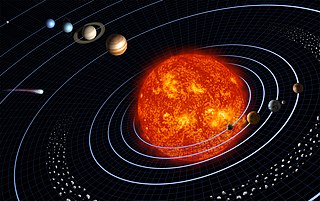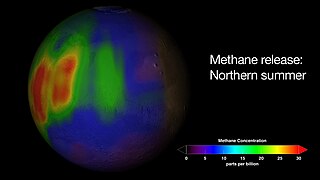
A Mars jar or Mars simulation chamber is a container that simulates the atmosphere of the planet Mars. It is used in astrobiology experiments to determine what kind of life on Mars might be viable.

A Mars jar or Mars simulation chamber is a container that simulates the atmosphere of the planet Mars. It is used in astrobiology experiments to determine what kind of life on Mars might be viable.
Mars jars have evolved from simple glass containers that resembled kitchen jars in the 1950s to sophisticated temperature-controlled pressure vessels that are now more commonly called "Mars environmental simulation chamber" or "Mars atmosphere simulation chamber". [1] In such devices, a variety of aspects of the Martian environment can be replicated, such as atmospheric composition and pressure, surface materials, temperature cycles and solar radiation.

The concept and the name "Mars jar" originate with Hubertus Strughold, a German physiologist and pioneering space medicine researcher. Strughold described Mars jars in his 1953 publication The Green and Red Planet: A Physiological Study of the Possibility of Life on Mars, in which he also coined the term "astrobiology". By 1956, Mars jars were part of U.S. Air Force research projects into crewed Mars missions. [1]
The concept was popularized outside military circles in 1957 by the biologist Joshua Lederberg, who proposed it to NASA leaders, and then by the astrophysicist and science educator Carl Sagan, who featured Mars jars in his TV shows. [1] According to the science historian Jordan Bimm, Strughold's work was not mentioned in later descriptions of Mars jars because civilian scientists wanted to avoid association with the military and with Strughold's involvement in human experimentation in Nazi Germany. [1]

Astrobiology, formerly known as exobiology, is an interdisciplinary scientific field that studies the origins, early evolution, distribution, and future of life in the universe. Astrobiology considers the question of whether extraterrestrial life exists, and if it does, how humans can detect it.

Extraterrestrial life is hypothetical life that may occur outside Earth and which did not originate on Earth. Such life might range from simple prokaryotes to intelligent beings and even sapient beings, possibly bringing forth civilizations that might be far more advanced than humanity. The Drake equation speculates about the existence of sapient life elsewhere in the universe. The science of extraterrestrial life in all its forms is known as astrobiology.

Terraforming or terraformation is the hypothetical process of deliberately modifying the atmosphere, temperature, surface topography or ecology of a planet, moon, or other body to be similar to the environment of Earth to make it habitable by Earth-like life.

The possibility of life on Mars is a subject of interest in astrobiology due to its proximity and similarities to Earth. To date, no proof of past or present life has been found on Mars. Cumulative evidence suggests that during the ancient Noachian time period, the surface environment of Mars had liquid water and may have been habitable for microorganisms, but habitable conditions do not necessarily indicate life.

In astronomy and astrobiology, the circumstellar habitable zone (CHZ), or simply the habitable zone, is the range of orbits around a star within which a planetary surface can support liquid water given sufficient atmospheric pressure. The bounds of the CHZ are based on Earth's position in the Solar System and the amount of radiant energy it receives from the Sun. Due to the importance of liquid water to Earth's biosphere, the nature of the CHZ and the objects within it may be instrumental in determining the scope and distribution of planets capable of supporting Earth-like extraterrestrial life and intelligence.
A biosignature is any substance – such as an element, isotope, or molecule – or phenomenon that provides scientific evidence of past or present life. Measurable attributes of life include its complex physical or chemical structures and its use of free energy and the production of biomass and wastes. A biosignature can provide evidence for living organisms outside the Earth and can be directly or indirectly detected by searching for their unique byproducts.

In 1976 two identical Viking program landers each carried four types of biological experiments to the surface of Mars. The first successful Mars landers, Viking 1 and Viking 2, then carried out experiments to look for biosignatures of microbial life on Mars. The landers each used a robotic arm to pick up and place soil samples into sealed test containers on the craft.

Planetary habitability is the measure of a planet's or a natural satellite's potential to develop and maintain environments hospitable to life. Life may be generated directly on a planet or satellite endogenously or be transferred to it from another body, through a hypothetical process known as panspermia. Environments do not need to contain life to be considered habitable nor are accepted habitable zones the only areas in which life might arise.

The atmosphere of Mars is the layer of gases surrounding Mars. It is primarily composed of carbon dioxide (95%), molecular nitrogen (2.8%) and argon (2%). It also contains trace levels of water vapor, oxygen, carbon monoxide, hydrogen and noble gases. The atmosphere of Mars is much thinner than Earth's. The average surface pressure is only about 610 pascals (0.088 psi) which is less than 1% of the Earth's value. The currently thin Martian atmosphere prohibits the existence of liquid water at the surface of Mars, but many studies suggest that the Martian atmosphere was much thicker in the past. The higher density during spring and fall is reduced by 25% during the winter when carbon dioxide partly freezes at the pole caps. The highest atmospheric density on Mars is equal to the density found 35 km (22 mi) above the Earth's surface and is ~0.020 kg/m3. The atmosphere of Mars has been losing mass to space since the planet formed, and the leakage of gases still continues today.

The terraforming of Mars or the terraformation of Mars is a hypothetical procedure that would consist of a planetary engineering project or concurrent projects, with the goal of transforming Mars from a planet hostile to terrestrial life to one that can sustainably host humans and other lifeforms free of protection or mediation. The process would presumably involve the rehabilitation of the planet's extant climate, atmosphere, and surface through a variety of resource-intensive initiatives, and the installation of a novel ecological system or systems.
Hubertus Strughold was a German-born physiologist and prominent medical researcher. Beginning in 1935 he served as chief of aeromedical research for Hermann Göring's Ministry of Aviation, holding this position throughout World War II. In 1947 he was brought to the United States as part of Operation Paperclip and went on to serve in a number of high-level scientific posts with the US Air Force and NASA.

The Mars general circulation model (MGCM) is the result of a research project by NASA to understand the nature of the general circulation of the atmosphere of Mars, how that circulation is driven and how it affects the climate of Mars in the long term.

The study of extraterrestrial atmospheres is an active field of research, both as an aspect of astronomy and to gain insight into Earth's atmosphere. In addition to Earth, many of the other astronomical objects in the Solar System have atmospheres. These include all the gas giants, as well as Mars, Venus, Titan and Pluto. Several moons and other bodies also have atmospheres, as do comets and the Sun. There is evidence that extrasolar planets can have an atmosphere. Comparisons of these atmospheres to one another and to Earth's atmosphere broaden our basic understanding of atmospheric processes such as the greenhouse effect, aerosol and cloud physics, and atmospheric chemistry and dynamics.

The habitability of natural satellites is a measure of the potential of natural satellites to have environments hospitable to life. Habitable environments do not necessarily harbor life. Natural satellite habitability is an emerging field which is considered important to astrobiology for several reasons, foremost being that natural satellites are predicted to greatly outnumber planets and it is hypothesized that habitability factors are likely to be similar to those of planets. There are, however, key environmental differences which have a bearing on moons as potential sites for extraterrestrial life.

Astrobiology Science and Technology for Exploring Planets (ASTEP) is a program established by NASA to sponsor research projects that advance the technology and techniques used in planetary exploration. The objective is to enable the study of astrobiology and to aid the planning of extraterrestrial exploration missions while prioritizing science, technology, and field campaigns.
Before the scientific search for and study of extrasolar planets, the possibility was argued through philosophy and science fiction. The mediocrity principle suggests that planets like Earth should be common in the Universe, while the Rare Earth hypothesis suggests that they are extremely rare. The thousands of exoplanetary star systems discovered so far are profoundly different from the Solar System, supporting the Rare Earth Hypothesis.
In astrobiology and planetary astrophysics, the galactic habitable zone is the region of a galaxy in which life might most likely develop. The concept of a galactic habitable zone analyzes various factors, such as metallicity and the rate and density of major catastrophes such as supernovae, and uses these to calculate which regions of a galaxy are more likely to form terrestrial planets, initially develop simple life, and provide a suitable environment for this life to evolve and advance. According to research published in August 2015, very large galaxies may favor the birth and development of habitable planets more than smaller galaxies such as the Milky Way. In the case of the Milky Way, its galactic habitable zone is commonly believed to be an annulus with an outer radius of about 10 kiloparsecs (33,000 ly) and an inner radius close to the Galactic Center.
Exposing Microorganisms in the Stratosphere (E-MIST) is a NASA study to determine if a specific microorganism could survive conditions like those on the planet Mars. The study transported Bacillus pumilus bacteria and their spores by helium-filled balloon to the stratosphere of Earth and monitored the ability of the microorganisms to survive in extreme Martian-like conditions such as low pressure, dryness, cold, and ionizing radiation.
David C. Catling is a Professor in Earth and Space Sciences at the University of Washington. He is a planetary scientist and astrobiologist whose research focuses on understanding the differences between the evolution of planets, their atmospheres, and their potential for life. He has participated in NASA's Mars exploration program and contributed research to help find life elsewhere in the solar system and on planets orbiting other stars. He is also known for his work on the evolution of Earth's atmosphere and biosphere, particularly how Earth's atmosphere became rich in oxygen and allowed complex life to evolve.

The reported presence of methane in the atmosphere of Mars is of interest to many geologists and astrobiologists, as methane may indicate the presence of microbial life on Mars, or a geochemical process such as volcanism or hydrothermal activity.